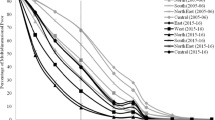Abstract
The multidimensional poverty index (MPI) is generally credited for better capturing the various components of poverty. Where such indexes have a spatial component, opportunity arises for analyzing changes in the spatial concentration of multidimensional poverty over given periods across space. Using current available MPI data for Gauteng province, South Africa, we apply spatial statistical analysis techniques to measure the degree of spatial concentration, spread and orientation of poverty across the various wards. Results reveal distinct variations in concentration, spatial spread and orientation of poverty across the province. These results open up possibilities of spatially targeted state interventions for reducing poverty.











Similar content being viewed by others
Notes
For example, average location, dispersion, and orientation or arrangement in space.
References
Alkire, S., & Foster, J. (2011). Understandings and misunderstandings of multidimensional poverty measurement. The Journal of Economic Inequality, 9, 289–314.
Anselin, L. (1995). Local indicators of spatial association—LISA. Geographical Analysis, 27, 93–115.
Anselin, L. (1996). The Moran scatterplot as an ESDA tool to assess local instability in spatial association. In M. Fischer, H. J. Scholten & D. Unwin (Eds.), Spatial analytical perspectives on GIS in environmental and socioeconomic sciences (pp. 111–125). London: Taylor and Francis.
Baud, I. S. A., Sridharan, N., & Pfeffer, K. (2008). Mapping urban poverty for local governance in an Indian mega-city: The case of Delhi. Urban Studies, 45, 1385–1412.
Cheruiyot, K. (2018). City-regions and their changing space economies. In K. Cheruiyot (Ed.), The changing space economy of city-regions (pp. 1–24). Cham: Springer.
Cheruiyot, K., & Mushongera, D. (2018). Testing economic growth convergence and its policy implications in the Gauteng City-Region. In K. Cheruiyot (Ed.), The changing space economy of city-regions (pp. 213–239). Cham: Springer.
Cliff, A. D., & Ord, J. K. (1981). Spatial processes: Models & applications. London: Taylor & Francis.
David, A., Guilbert, N., Hamaguchi, N., Higashi, Y., Hino, H., Leibbrant, M., et al. (2018). Spatial poverty and inequality in South Africa: A municipality level analysis. AFD Research Papers Series, No. 2018-66, January.
Epprecht, M., Minot, N., Dewina, R., Messerli, P., & Heinimann, A. (2008). The geography of poverty and inequality in the Lao PDR. Bern: Geographica Bernensia.
Everatt, D. (2017). Quality of Life in the Gauteng City-Region, South Africa. Social Indicators Ressearch, 130, 71–86.
GCRO QoL. (2015). Quality of Life survey. http://www.gcro.ac.za/research/project/detail/quality-of-life-survey-iv-2015/. Accessed June 06, 2018.
Kwenda, P., & Benhura, M. (2018). Poverty and inequality in the GCR: Inequalities in the GCR labour market. GCRO Research Report, Johannesburg.
Lefever, D. Welty. (1926). Measuring geographic concentration by means of the standard deviational ellipse. American Journal of Sociology, 32, 88–94.
Moran, P. A. (1948). The interpretation of statistical maps. Journal of the Royal Statistical Society: Series B (Methodological), 10, 243–251.
Mushongera, D., Zikhali, P., & Ngwenya, P. (2017). A multidimensional poverty index for Gauteng province, South Africa: Evidence from Quality of Life survey data. Social Indicators Research, 130, 277–303.
OECD. (2011). OECD territorial reviews: The Gauteng City-Region, South Africa 2011. Paris: OECD Publishing. https://doi.org/10.1787/9789264122840-en.
Okwi, P. O., Ndeng’e, G., Kristjanson, P., Arunga, M., Notenbaert, A., Omolo, A., et al. (2007). Spatial determinants of poverty in rural Kenya. Proceedings of the National Academy of Sciences, 104, 16769–16774.
Orford, S. (2004). Identifying and comparing changes in the spatial concentrations of urban poverty and affluence: A case study of inner London. Computers, Environment and Urban Systems, 28, 701–717.
Parilla, J., & Trujillo, J. L. (2015). South Africa’s global gateway: Profiling the Gauteng City-Region’s international competitiveness and connections. Global Cities Initiative, a Joint Project of Brookings and J P Morgan Chase.
StatsSA. (2014). The South African MPI, Creating a multidimensional poverty index using census data. http://www.statssa.gov.za/publications/Report-03-10-08/Report-03-10-082014.pdf. Accessed October 04, 2017.
StatsSA. (2017). Poverty Trends in South Africa, An examination of absolute poverty between 2006 and 2015. http://www.statssa.gov.za/publications/Report-03-10-06/Report-03-10-062015.pdf. Accessed October 04, 2017.
Thongdara, R., Samarakoon, L., Shrestha, R. P., & Ranamukhaarachchi, S. L. (2012). Using GIS and spatial statistics to target poverty and improve poverty alleviation programs: A case study in northeast Thailand. Applied Spatial Analysis and Policy, 5, 157–182.
Tobler, W. R. (1970). A computer movie simulating urban growth in the Detroit region. Economic Geography, 46, 234–240.
Tseng, D. (2018). Poverty and inequality in the GCR: Income and expenditure analysis. GCRO Research Report, Johannesburg.
Vista, B. M., & Murayama, Y. (2011). Spatial determinants of poverty using GIS-based mapping. In Y. Murayama & R. Thapa (Eds.), Spatial analysis and modeling in geographical transformation process (pp. 275–296). Dordrecht: Springer.
Wong, D. W. (1999). Geostatistics as measures of spatial segregation. Urban Geography, 20, 635–647.
Wong, D. W. (2003). Implementing spatial segregation measures in GIS. Computers, Environment and Urban Systems, 27, 53–70.
Yuill, R. S. (1971). The standard deviational ellipse; an updated tool for spatial description. Geografiska Annaler: Series B, Human Geography, 53, 28–39.
Acknowledgements
This work benefited from comments from colleagues in the GCRO in particular the QoL team that worked on the data.
Author information
Authors and Affiliations
Corresponding author
Additional information
Publisher's Note
Springer Nature remains neutral with regard to jurisdictional claims in published maps and institutional affiliations.
Rights and permissions
About this article
Cite this article
Katumba, S., Cheruiyot, K. & Mushongera, D. Spatial Change in the Concentration of Multidimensional Poverty in Gauteng, South Africa: Evidence from Quality of Life Survey Data. Soc Indic Res 145, 95–115 (2019). https://doi.org/10.1007/s11205-019-02116-w
Accepted:
Published:
Issue Date:
DOI: https://doi.org/10.1007/s11205-019-02116-w




